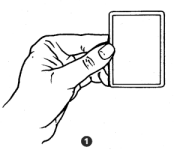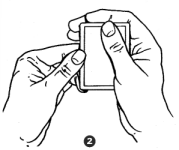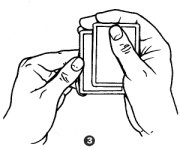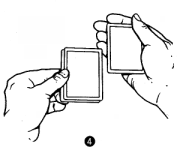Elmsley Count
Well you may say that I am mad and out of my mind trying to teach a sleight that has been around for ages and should by now be known by all. But it is surprising how many magicians approach me during my lectures at conventions and ask me to teach them the Elmsley Count. Do not forget also that we have many newcomers in magic every year and I do not intend to forget them.
A good deal of the tricks explained in this book use this deceptive count and I wanted the book to be complete. Another point is that it is amazing how many magicians still perform the Elmsley Count with the old fingertips grip (which was made popular by the Dai Vernon classic trick Twisting The Aces) and do not use the now standard (and better) ‘dealing position grip.’ (This trick was written so clearly by Lewis Ganson in the Dai Vernon book, More Inner Secrets of Card Magic.) The first time I ever saw this grip it was written in MAGIGRAM by my friend Lewis Ganson; I have no idea who did it for the first time.
You may also find some tips that will help you to improve YOUR Elmsley Count. The count is also known as The Ghost Count or Counting Four As Four, but it is well accepted by all as The Elmsiey Count after Alex Elmsley (from England) who developed it both from the Eye Count by Edward Victor (basically the same count but performed with three cards) and from the Jordan Count (which hides the fourth card from the top and not the third from the top as the Elmsley Count) with some help, if I am not wrong, from Roy Wolton. End of credits and chatter! So, here it is, ladies and gentlemen, my favorite move: The Elmsley Count.
Effect
Not a trick but a method to show four (or five) cards face down while one of the cards is face up; or four face-up cards while one is face down; or to show four red (or black) cards while one of them is black (or red); or to hide a different colored backed card among others; or . well, let’s just say it is a very versatile utility move!
Performance
|
You may perform this special count with four, five, six or even more cards, although with six or more cards it is not easy to hide the thickness of the packet. Let’s explain it with four cards, which is the basic number used in many effects. You will see that once you have mastered it, you may be able to use more cards with no problem at all. By way of explanation, take any four cards and place them in this order from top to bottom: Two cards are face down, the THIRD from the top is FACE UP and the bottom card is face down. Grip the packet in the left hand. The cards are held in the middle of the left long side between the forefinger, middle and third finger of the left hand from below and the left thumb from above. The position of the left thumb is very important. The very tip of the left thumb is on the edges of the cards and NOT resting on the top card. (This important tip has been left out of many explanations of the count.) You’ll see why it’s so important later on. Carefully study figure 1. The right hand approaches the packet bringing the thumb on top and the fingers below the cards. Note the position of the right forefinger. It is on the outer short side of the cards so if you had to release the left hand grip, the cards would be in a sort of right hand dealing position. Carefully study figure 2.
By slightly pressing down on the top card with the right thumb (which is on the right outer comer of the packet), move the right hand to the right AND slightly forward, moving the top card with the right thumb as in figure 3. The forefinger is on the outer short side of the card. Continue moving the right hand to clear the top card from the packet (figure 4). The card falls in a sort of dealing position in the right hand. At the same time, the left thumb tip pushes the top two cards as one about a quarter of an inch to the right and slightly forward (study figure 4 once again). Note that the two cards are side jogged to the right but also out-jogged forward.
|




|
Bring the right hand (and the card) back to the left hand. The right hand card goes directly BETWEEN THE OTHER CARDS AND THE LEFT (this card slides under the cards held by the left hand by being pushed by the right fingers — mainly the forefinger). The right thumb is slightly lifted to allow the other cards to move below it. The right hand card is taken below the packet by the left fingers. AT THE SAME TIME, the right thumb and forefinger take the top two cards of the packet (the two cards previously moved by the left thumb), similar to figure 3 but with two cards below the right thumb. The cards are gripped by the right thumb and forefinger and kept squared (remember, the bottom card of the duo is face up). Continue moving the right hand to the right and slightly forward as in figure 4 (but without any movement by the left thumb this time).
The right hand approaches the left hand again and the two cards held by the right hand are moved below the left-hand cards. The left thumb pushes the top card of the left hand duo to the right and this card is taken by placing the right thumb on top of it as before, repeating the previous move. The right hand as before moves to the right so that this third card falls onto the other two.
Finally, the last card held in the left hand is taken onto the three cards held in the right hand by repeating the same moves.
Apparently you have just reversed the order of the cards while counting them by passing them one by one from the left hand to the right. Actually, what happens is that the first card is counted twice and the third card from the top, which is never seen, has changed position and is now fourth from the top (on the bottom). This puts the cards in position to execute a Jordan Count which keeps the bottom card concealed.
Notes
If you have a five (or six) card packet the basic moves do not change. After the first card has moved into the right hand, the left thumb pushes three (or four) cards (instead of two) and the moves remain the same.
Of course the cards can also be counted face up and still the third card is never seen. Remember when you count the cards face up however, that the first card will be seen twice. So use the count discreetly in this instance (by using, for example, high spot cards — such as Nines and Eights).
You can also do the move by starting with the cards in the right hand and taking them with the left hand. This way you have the advantage of the cards ending up directly in the left hand dealing position.
|
